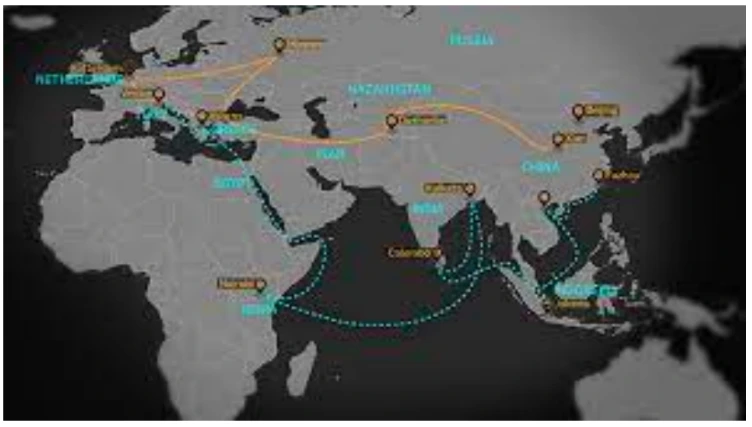Answer:
Approach:
- Introduction: Provide a brief overview of China’s Belt and Road Initiative, highlighting its ambition and the scope of infrastructure and connectivity plans.
- Body:
- Discuss “Debt Sustainability”.
- Explore the “Geopolitical Influence and Strategic Dimensions”.
- Comment on “Environmental and Social Impact”.
- Address the issue of “Lack of Transparency and Governance”.
- Acknowledge the positive “Economic Growth and Infrastructure Development”.
- Discuss the “Shift in Global Economic Power,” explaining how BRI is reorienting global trade and political dynamics in favour of China.
- Mention “Cultural and People-to-People Exchange” as part of China’s soft power strategy through BRI.
- Talk about the “Creation of Dependency,” elaborating on how economic reliance on China influences political and strategic decisions in participating countries.
- Conclusion: Conclude by reinforcing the need for participant countries to meticulously analyze the costs and benefits of their engagement with the BRI, considering its profound influence on future geopolitical dynamics.
|
Introduction:
China’s Belt and Road Initiative (BRI), conceptualized in 2013, represents one of the most ambitious infrastructural projects in modern history, entailing significant economic, political, and strategic undertones. The initiative aims to enhance regional connectivity and embrace economic diplomacy through a vast network of infrastructure projects, including roads, ports, and railways, stretching from East Asia to Europe. While the project promises economic opportunities and infrastructural development, it has raised considerable concerns globally.
Body:
Concerns Associated with BRI:
- Debt Sustainability:
- One of the most pressing concerns is the potential debt trap for countries involved in the BRI.
- Several states, especially developing ones with already precarious financial positions, have plunged further into debt due to the financing structure of BRI projects.
- For instance, Sri Lanka had to lease the strategic Hambantota port to China for 99 years after failing to meet its debt obligations, raising alarm about similar situations in other countries.
- Geopolitical Influence and Strategic Dimensions:
 The BRI isn’t merely an economic project; it carries significant geopolitical implications.
The BRI isn’t merely an economic project; it carries significant geopolitical implications. - By investing in extensive infrastructural projects, China potentially gains considerable influence in key strategic regions.
- For example, the development of the Gwadar port in Pakistan is viewed as an effort to secure China’s control over strategic maritime locations.
- Environmental and Social Impact:
- Large scale construction without adequate environmental safeguarding leads to ecological imbalance.
- Projects under the BRI have received criticism for inadequate environmental and social impact assessments.
- In countries like Indonesia and Kenya, BRI projects have faced resistance due to concerns over environmental degradation and community displacement.
- Lack of Transparency and Governance:
- There is significant concern over the lack of transparency in the agreement processes, project assessments, and financial terms associated with BRI projects.
- Such opacity raises questions about the viability and fairness of these projects, fueling suspicions regarding China’s broader strategic motives.
Impacts of BRI:
- Economic Growth and Infrastructure Development:
- Despite the concerns, the BRI facilitates substantial infrastructure development in participating countries.
- It has the potential to revitalize regional connectivity, reduce transportation costs, and create economic clusters.
- For example, the China-Central Asia-West Asia corridor aims to enhance trade links between these regions, fostering new economic opportunities.
- Shift in Global Economic Power:
- The BRI is shifting the epicenter of economic gravity towards Asia, particularly China. By essentially funding and controlling vital infrastructure worldwide, China is poised to reshape global trade patterns and, consequently, the geopolitical landscape.
- Cultural and People-to-People Exchange:
- Beyond the hard infrastructure, China is actively promoting cultural exchange and tourism through the BRI, facilitating people-to-people bonds.
- This aspect, though less discussed, is crucial for China’s soft power strategy, enhancing its global image.
- Creation of Dependency:
- The expansion of Chinese influence through the BRI also means greater economic dependency on China for participant countries.
- This relationship allows China to wield considerable influence over their political decisions, potentially reshaping regional dynamics and alliances.
The Belt and Road Initiative, transcending its initial portrayal as a benign infrastructural project, has evolved into a complex array of economic and strategic layouts, eliciting a global debate on its implications. While infrastructural development and economic growth are laudable objectives, the concerns regarding debt sustainability, environmental impacts, and geopolitical reconfigurations cannot be sidelined.
Conclusion:
The BRI serves as a testament to China’s ascending position in global affairs, but it also underscores the necessity for international mechanisms that ensure fair, transparent, and sustainable development practices in global infrastructural projects. For countries partnering with China, it is imperative to weigh the economic benefits against the potential strategic costs carefully. As the BRI continues to evolve, its reception and the narratives around it will significantly impact regional dynamics and the broader contours of global geopolitics.
To get PDF version, Please click on "Print PDF" button.
 The BRI isn’t merely an economic project; it carries significant geopolitical implications.
The BRI isn’t merely an economic project; it carries significant geopolitical implications. 
https://uploads.disquscdn.com/images/ae687e2adfb614a462639e8affbdc03b4cfdbad4400ec86143f40695f736d8b5.jpg https://uploads.disquscdn.com/images/e643e2cd0aa0211f18bfbab2ee9214255b8c43b5abf7c94eaf83084e9c619298.jpg
https://uploads.disquscdn.com/images/64b4573207ca9f8a1712dc429222307c113f538be3e9af859663ddd5b34f7829.jpg https://uploads.disquscdn.com/images/22e91d7bcb0d3b60d96556693f41088bb8164d9a8cb1e15c5384a2c6d6f41567.jpg https://uploads.disquscdn.com/images/5c15d41188007c314b36f0c5530a5914943fec2f726fd53cd22d7be06a6fb051.jpg
https://uploads.disquscdn.com/images/652290c1b06aeddcc5f685e86de39c7a47394a30db220d6f1f8cca26ab614576.jpg https://uploads.disquscdn.com/images/cea092c22a1b93a1d311a66cb72dd3699c47ec7d98ae420de959c679ff430733.jpg https://uploads.disquscdn.com/images/e935661564479b390dcea5d547de71d0e6288decfd8e776b6e2152a6f0e292d7.jpg
https://uploads.disquscdn.com/images/a51c0f41b9aca2731d87cd1ea24724d3b0f7e28a9dfa6b30c15602127c7da72b.jpg https://uploads.disquscdn.com/images/9558302436af4524b0497e9f7490c00269f34fe14c577e2cc2a80f99f35d7537.jpg https://uploads.disquscdn.com/images/6815d7307aba8e9b0929b51042192d8f6df02ab7fef8c40df02169253eea5812.jpg
https://uploads.disquscdn.com/images/5e5f725f047ed8c14f11eb583b96f1181288b6cbab7d6c64d913ada8b920bc9b.jpg https://uploads.disquscdn.com/images/c399899b37b030005a57d933956ae91f709ea3c723ff2abe7921dd5c0967ee17.jpg